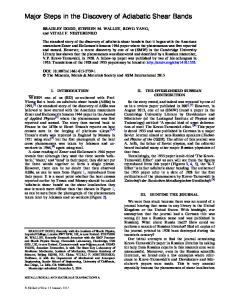Thermomechanics of Cosserat medium: modeling adiabatic shear bands in metals
- PDF / 1,245,497 Bytes
- 20 Pages / 595.276 x 790.866 pts Page_size
- 106 Downloads / 323 Views
O R I G I NA L A RT I C L E
Raffaele Russo
· Samuel Forest · Franck Andrés Girot Mata
Thermomechanics of Cosserat medium: modeling adiabatic shear bands in metals
Received: 18 March 2020 / Accepted: 28 September 2020 © Springer-Verlag GmbH Germany, part of Springer Nature 2020
Abstract During most metal manufacturing processes, the medium deforms by generating large quantities of plastic strain at relatively high strain rates, inevitably inducing rises in temperature. Metals characterized by low thermal conductivity properties might locally retain high temperatures, consequently undergoing thermal softening. The classical balance laws governing the continuum equilibrium show severe mesh sensitivity if they were numerically discretized through finite element methods. Furthermore, the plastic deformation tends to localize in narrow areas whose characteristic length is comparable to grain size, thereby requiring the adoption of theories able to predict size-effects. In this manuscript we demonstrate that the Cosserat medium is able to overcome these issues related to manufacturing processes simulation. We first provide a thermodynamicallyconsistent description of the Cosserat medium, and then we propose a method to calibrate the two additional characteristic lengths introduced by the Cosserat medium description by enriching the model with the TANH stress flow rule under adiabatic conditions. Keywords Cosserat medium · Thermodynamics · Elastoviscoplasticity · Characteristic length · Adiabatic shear band
1 Introduction Manufacturing processes of metallic materials can be found in almost every engineering field, e.g. aerospace, naval and civil. Performing the numerical simulations of the processes, however, still represents a big challenge in many aspects. The material, in fact, during the process, experiences prohibitive deformation fields, consequently reaching very high temperatures, close to the material melting point. From the physical standpoint, a properly adapted model is necessary to obtain results from the simulation that would describe the real medium development. Communicated by Emilio Barchiesi. R. Russo (B)· F. A. G. Mata Department of Mechanical Engineering, Faculty of Engineering, University of the Basque Country, 48013 Bilbao, Spain E-mail: [email protected] R. Russo Centre des Matériaux, Mines-ParisTech, 91003 Evry Cedex, France S. Forest Centre des Matériaux, Mines-ParisTech, CNRS UMR 7633, PSL Research University, BP 87, 91003 Evry Cedex, France F. A. G. Mata IBERBASQUE, Basque Foundation for Science, Bilbao, Spain
R. Russo et al.
During machining, for example, the metal is shaped into its final form through removal of small quantities of material, which is shredded from the final piece through shear deformation mainly. The material locally experiences high plastic deformation, which induce, if the adiabatic condition is met (the thermal diffusion is characterized by a lower velocity than heat production rate), to locally retain high temperatures, thus leading to material thermal-softeni
Data Loading...











